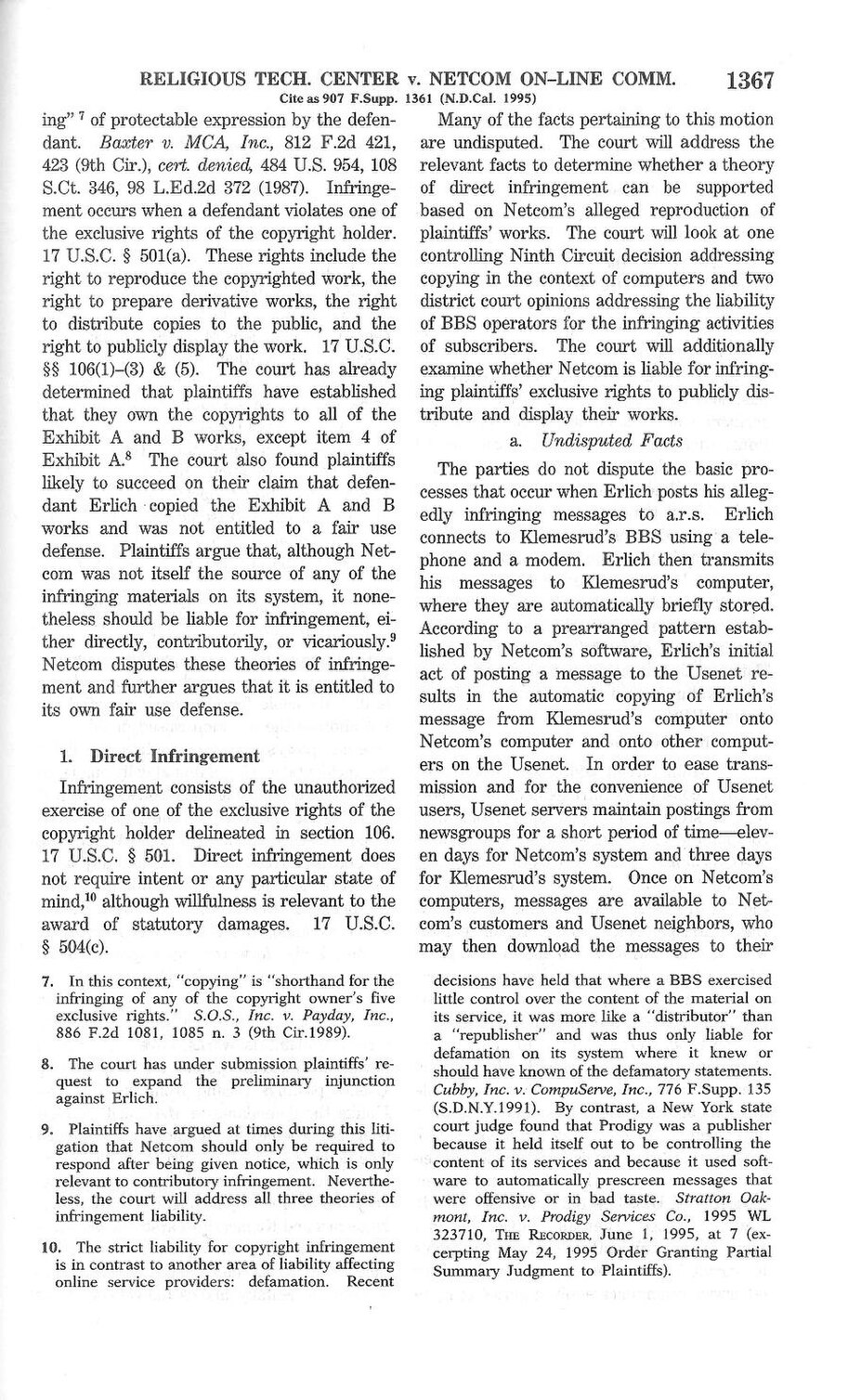Cite as 907 F.Supp. 1361 (N.D.Cal. 1995)
ing”[1] of protectable expression by the defendant. Baxter v. MCA, Inc., 812 F.2d 421, 423 (9th Cir.), cert. denied, 484 U.S. 954, 108 S.Ct. 346, 98 L.Ed.2d 372 (1987). Infringement occurs when a defendant violates one of the exclusive rights of the copyright holder. 17 U.S.C. § 501(a). These rights include the right to reproduce the copyrighted work, the right to prepare derivative works, the right to distribute copies to the public, and the right to publicly display the work. 17 U.S.C. §§ 106(1)–(3) & (5). The court has already determined that plaintiffs have established that they own the copyrights to all of the Exhibit A and B works, except item 4 of Exhibit A.[2] The court also found plaintiffs likely to succeed on their claim that defendant Erlich copied the Exhibit A and B works and was not entitled to a fair use defense. Plaintiffs argue that, although Netcom was not itself the source of any of the infringing materials on its system, it nonetheless should be liable for infringement, either directly, contributorily, or vicariously.[3] Netcom disputes these theories of infringement and further argues that it is entitled to its own fair use defense.
- 1. Direct Infringement
Infringement consists of the unauthorized exercise of one of the exclusive rights of the copyright holder delineated in section 106. 17 U.S.C. § 501. Direct infringement does not require intent or any particular state of mind,[4] although willfulness is relevant to the award of statutory damages. 17 U.S.C. § 504(e).
Many of the facts pertaining to this motion are undisputed. The court will address the relevant facts to determine whether a theory of direct infringement can be supported based on Netcom’s alleged reproduction of plaintiffs’ works. The court will look at one controlling Ninth Circuit decision addressing copying in the context of computers and two district court opinions addressing the liability of BBS operators for the infringing activities of subscribers. The court will additionally examine whether Netcom is liable for infringing plaintiffs’ exclusive rights to publicly distribute and display their works.
a. Undisputed Facts
The parties do not dispute the basic processes that occur when Erlich posts his allegedly infringing messages to a.r.s. Erlich connects to Klemesrud’s BBS using a telephone and a modem. Erlich then transmits his messages to Klemesrud’s computer, where they are automatically briefly stored. According to a prearranged pattern established by Netcom’s software, Erlich’s initial act of posting a message to the Usenet results in the automatic copying of Erlich’s message from Klemesrud’s computer onto Netcom’s computer and onto other computers on the Usenet. In order to ease transmission and for the convenience of Usenet users, Usenet servers maintain postings from newsgroups for a short period of time—eleven days for Netcom’s system and three days for Klemesrud’s system. Once on Netcom’s computers, messages are available to Netcom’s customers and Usenet neighbors, who may then download the messages to their
- ↑ In this context, “copying” is “shorthand for the infringing of any of the copyright owner’s five exclusive rights.” S.O.S., Inc. v. Payday, Inc., 886 F.2d 1081, 1085 n. 3 (9th Cir.1989).
- ↑ The court has under submission plaintiffs’ request to expand the preliminary injunction against Erlich.
- ↑ Plaintiffs have argued at times during this litigation that Netcom should only be required to respond after being given notice, which is only relevant to contributory infringement. Nevertheless, the court will address all three theories of infringement liability.
- ↑ The strict liability for copyright infringement is in contrast to another area of liability affecting online service providers: defamation. Recent decisions have held that where a BBS exercised little control over the content of the material on its service, it was more like a “distributor” than a “republisher” and was thus only liable for defamation on its system where it knew or should have known of the defamatory statements. Cubby, Inc. v. CompuServe, Inc., 776 F.Supp. 135 (S.D.N.Y.1991). By contrast, a New York state court judge found that Prodigy was a publisher because it held itself out to be controlling the content of its services and because it used software to automatically prescreen messages that were offensive or in bad taste. Stratton Oakmont, Inc. v. Prodigy Services Co., 1995 WL 323710, The Recorder, June 1, 1995, at 7 (excerpting May 24, 1995 Order Granting Partial Summary Judgment to Plaintiffs).
